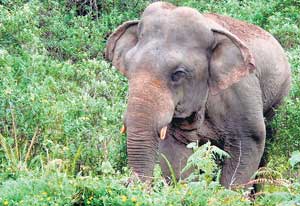All was silent in Sinharaja. Police and the civil guards were in the leech-infested terrain, moving stealthily to avoid stepping onto trap guns when they heard a gun shot and an elephant's painful cry echoed across the jungle.
One of the three remaining elephants roaming around the periphery of Sinharaja had been shot. The Police team quickly sealed off the area and nabbed the culprit who was armed with an unlicensed T56.
The man-a notorious illicit liquor maker confessed to shooting the elephant. Fortunately it was not badly hurt.
It was indeed an eventful week for the villagers and the elephants at Sinharaja. Sunday, July 13 started with a tragedy in Kopi Kella - a small village in Rakwana when villagers tried to chase away an elephant that had been enjoying the fruits of a villager's orchard.
Angered by a firecracker, the elephant attacked, fatally injuring Lalith Rajaratne a 40-year-old villager. The elephant was in musth and hence dangerous, said Lal, a man from the adjoining village.
"These elephants are naturally shy. They used to inhabit the Walan Kanda sanctuary, but their natural habitats have been disturbed, forcing them to come down to the villages regularly," said B.A.
Muthubanda, an Assistant Director of the Department of Wildlife Conservation (DWLC). Muthubanda looks after the Southern region. Rainforests like Sinharaja mainly have canopy level trees, giving the elephants limited foraging options. So the elephants of Sinharaja need to move constantly from forest to forest to find food unlike their cousins in the Dry Zone who enjoy the grasslands and savannah habitats.
The elephants had a traditional path they used to move through freely, but these routes are blocked mainly by the emerging tea plantations. Even the forests around Walan Kanda that belonged to the Land Reclamation Commission were distributed to tea planters limiting the options available to these three elephants forcing them to find new routes These unfortunately cross the villages near Rakwana making Sinharaja another theatre for the human / elephant conflict.
Those who live in Kopikella, Rambuka, Kajugaswatta, Pahe Kanuwa and Beverly Estate have had close encounters with these jumbos. Nilantha Abeywardene, a teacher at the Rambuka School said these jumbos sometimes damage houses and raid crops, but usually avoid humans. They were not to be seen for about five-six months, but suddenly appeared in the periphery of his village a few weeks ago, he said.
Is it a seasonal movement? Dulan Ranga, who lives in Deniyaya said that elephants enter into 'Morning Side' of Sinharaja usually during September and stay until November.
Wildlife experts are also concerned. "Recently we've seen the evidence of the presence of these three elephants in Sinharaja Morning Side. They had walked through an old cardamon plantation and a tea estate, destroying some of the bushes. It is apparent that tea plantations encroached and blocked these elephants' traditional routes. Action has to be taken to stop this illegal encroachment immediately.
It is also suggested to study the health conditions and chance of survival in isolation of these elephants and take a decision as per expert advice regarding their future. WNPS' Elephant Sub-committee is also monitoring the situation closely," Douglas Ranasinghe, President - Wildlife and Nature Protection Society (WNPS) told The Sunday Times.
Rakwana needs DWLC unit |
At present wildlife officers have to come all the way from Kalawana to Rakwana for any crisis. Rakwana is quite far from the Kalawana wildlife office and a delay can be fatal to either human or elephant.
Divisional Secretary of Kalawana, Mahinda S. Weerasuriya says a permanent DWLC unit for Rakwana is the need of the hour and suggests it could be set up in the Pothupitiya Govi Jana Sewa building located in the heart of the problem area. |
Elephant expert Dr. Prithviraj Fernando also stressed the need to study these elephants, as Wet Zone elephants may have unique behaviour patterns. Sinharaja has only three elephants and the Peak Wilderness (around Sri Pada) has a few more herds. Even the African Elephants were categorised as two species recently - Savannah Elephants who inhabit the grasslands and Bush Elephants who inhabit the forests. So it may be the time for full scale research to understand the behaviour of wet zone elephants, before it is too late.
Unlike in other areas of the country where there is a human-elephant conflict, most villagers prefer that the elephants remain in their villages.
In 1994, a team led by Dr. Nandana Atapattu of the Department of Wildlife Conservation tranquilized and captured an elephant here intending to move it, but were stalled by protesting schoolchildren and villagers. The villagers fed the weakened jumbo for four days until it could walk on its own. It was probably the first and only example of a village at risk by elephants not wanting the animals removed.
Like in 1994, a voice is once again being raised that the elephants need to be relocated. But the villagers are in a quandary. They do not want to send the jumbos away from Sinharaja, but they also need a solution to live without fear from the very same animals.
"The elephants’ presence in the forest indeed helps to reduce illegal activities in the forests as humans fear to go inside the jungle," reiterated the Rakwana police OIC U.P. Nelumdeniya.
It is clear, a management plan is needed to tackle this issue before it costs another human or elephant life. | 
